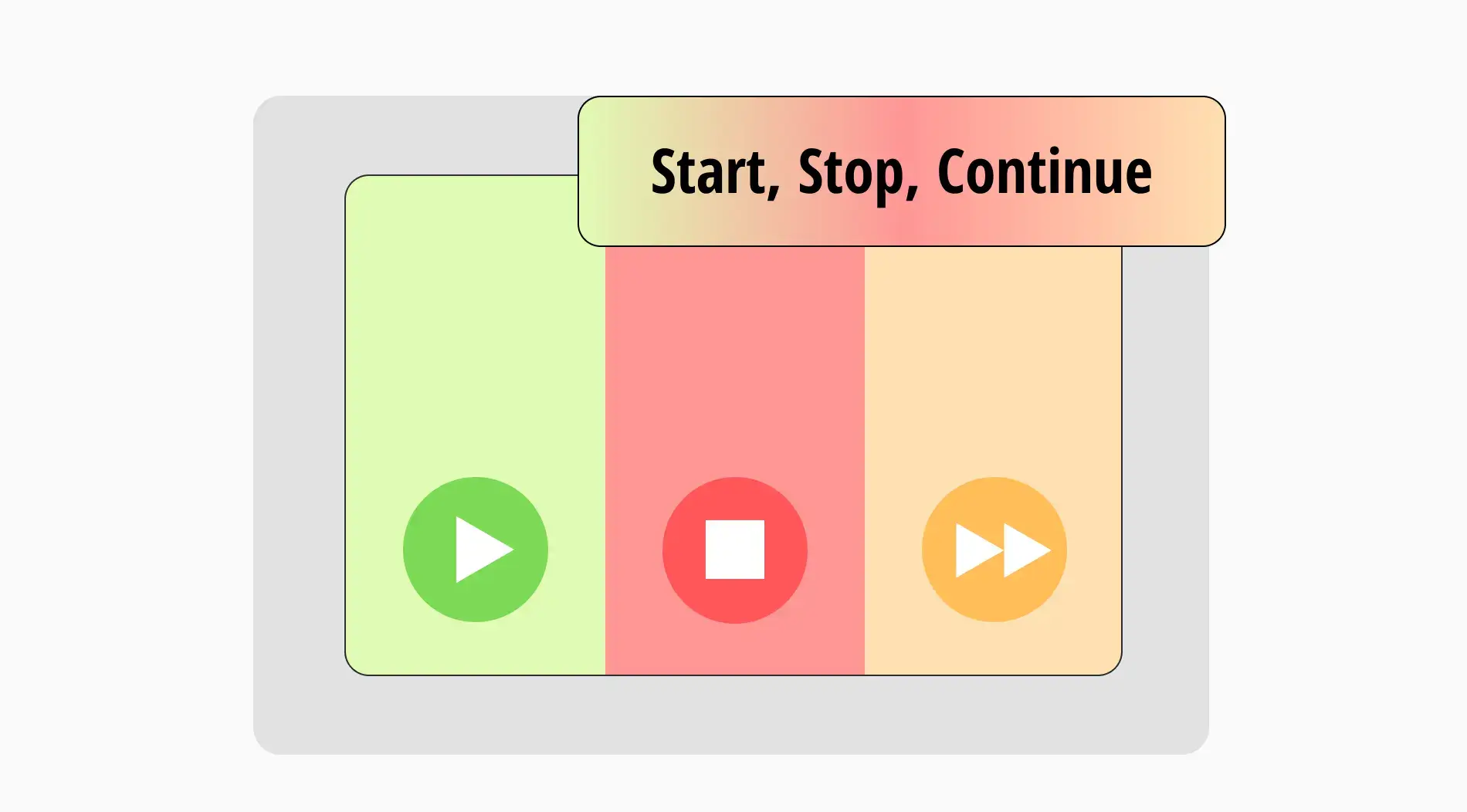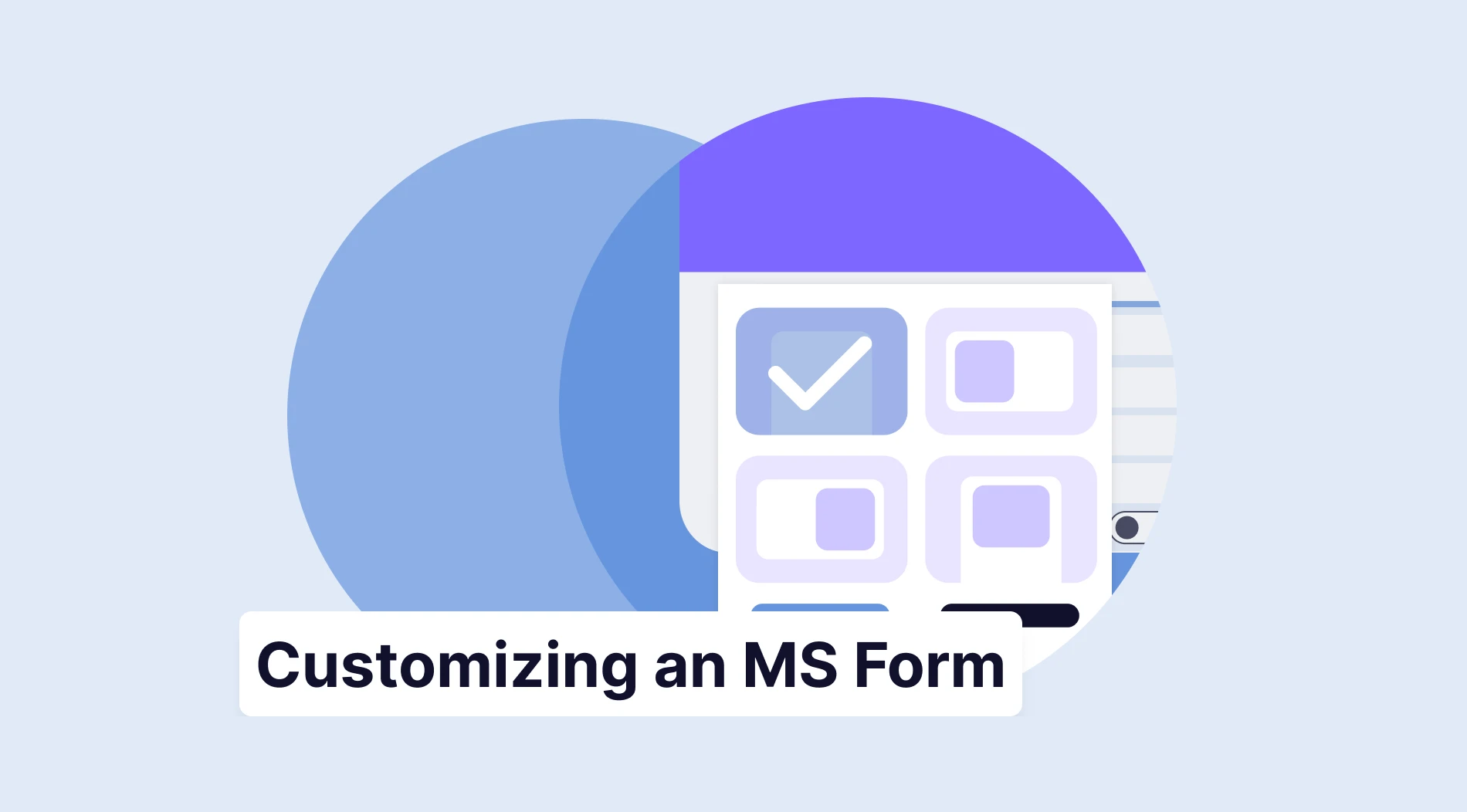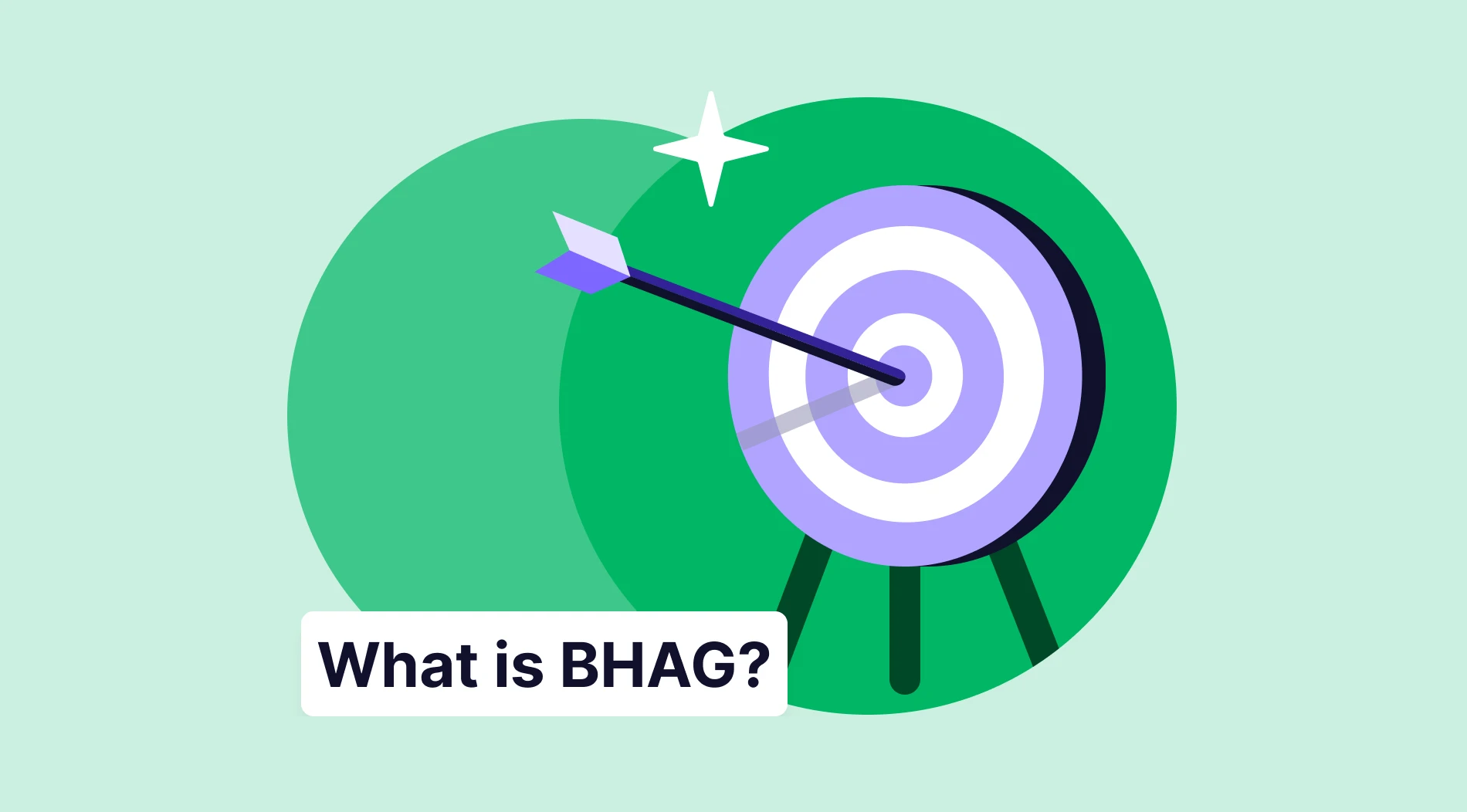In today's dynamic business landscape, understanding feedback frameworks isn't just advantageous; it's imperative. They serve as navigational tools, guiding individuals and organizations through the complexities of growth and adaptation. By embracing models like "Start, Stop, Continue," businesses unlock the power of structured feedback, fostering agility, innovation, and sustained success in an ever-evolving marketplace.
Today, we dive into a journey through one of the most potent feedback frameworks in the modern business world: the "Start, Stop, Continue" retrospective. We will see its details as we explore effective implementation strategies and practical insights from case examples, uncover its manifold advantages, and address common queries surrounding this tool.
What is the start, stop, and continue method?
The "Start, Stop, Continue" (SSC) method is a structured feedback model that fosters personal and professional growth by providing actionable feedback. This framework comprises three key components: identifying actions to start, cease, and maintain.
Through its structured approach, individuals and teams gain clarity on areas for improvement and strategies for sustained success.
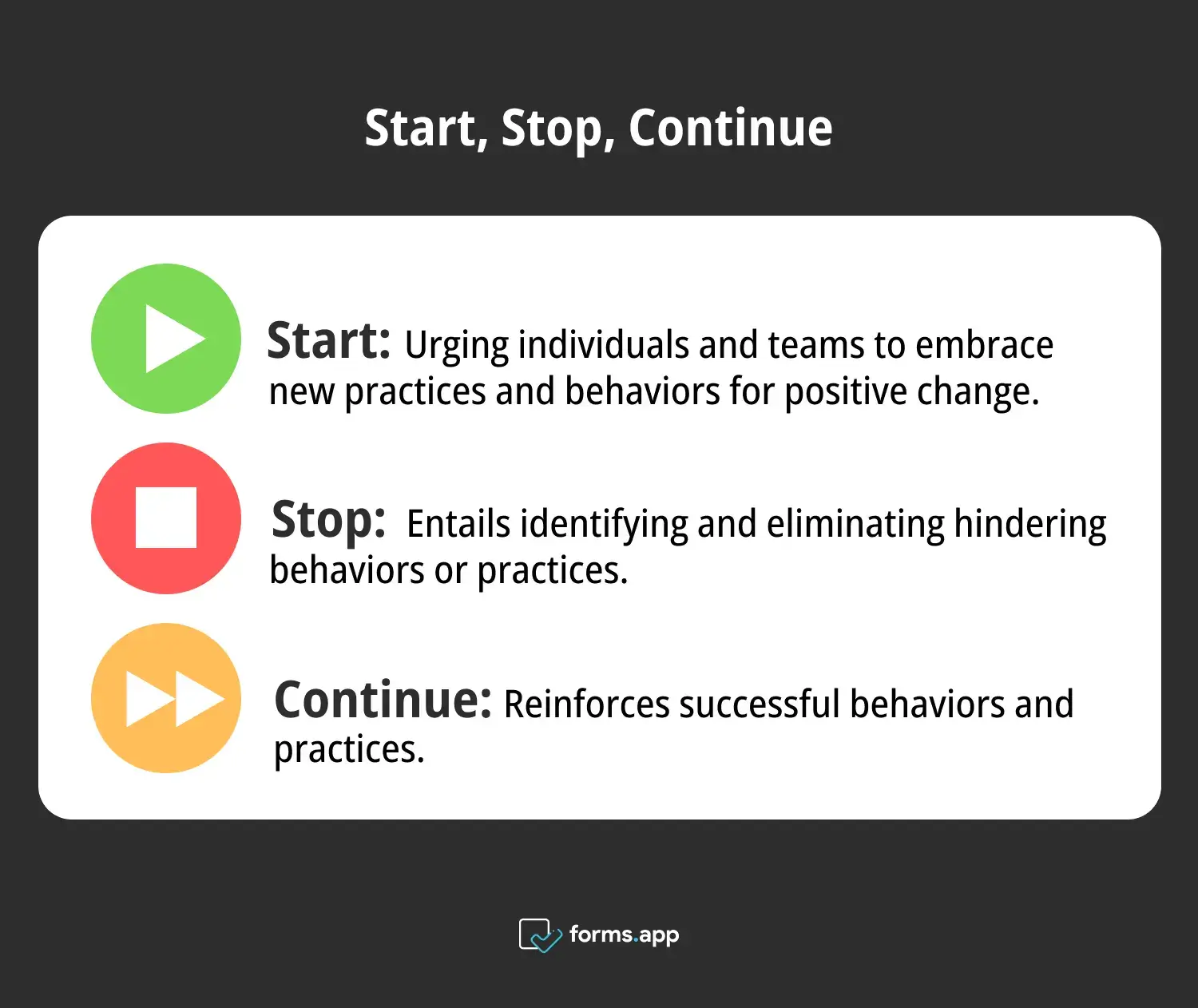
Start - Stop - Continue Method
Start
The "Start" phase of the "Start, Stop, Continue" model ignites a call to action, urging individuals and teams to embrace new practices and behaviors for positive change. It prompts stepping out of comfort zones and taking proactive steps towards growth, such as initiating skill development programs and fostering a culture of collaboration.
In today's fast-paced business world, stagnation is a barrier to success. The "Start" phase prompts organizations or companies to embrace innovation and forward-thinking initiatives. This involves launching new projects, exploring alternative problem-solving approaches, and adopting cutting-edge technologies to stay competitive against your rivals.
By actively seeking growth opportunities and embracing new approaches, organizations can position themselves as industry leaders. The "Start" phase not only drives progress but also fosters a culture of innovation and adaptability, essential traits for thriving in an ever-evolving market landscape.
Stop
The "Stop" phase of the "Start, Stop, Continue" model entails identifying and eliminating hindering behaviors or practices. It requires acknowledgment and addressing of counterproductive habits undermining success, whether procrastination, outdated processes, or negative thought patterns, clearing the path for new opportunities.
Beyond external behaviors, internal beliefs can impede progress. The "Stop" phase challenges individuals to confront and overcome limiting beliefs obstructing success. Letting go of self-doubt, fear, or other negative beliefs empowers individuals to unleash creativity, resilience, and drive, unlocking new avenues for growth and achievement.
By breaking free from mental barriers, individuals can embrace risk-taking and pursue goals with confidence. The "Stop" phase encourages individuals to cultivate a mindset conducive to growth and achievement. With renewed determination and belief in their abilities, individuals can chart new paths and realize their full potential.
Continue
The "Continue" phase of the "Start, Stop, Continue" model reinforces successful behaviors and practices. It sustains positive momentum by prioritizing tasks aligning with goals, fostering open communication, and promoting a culture of learning. By doubling down on these actions, individuals and teams ensure continued success and growth over time.
Success often stems from strengths and best practices. The "Continue" phase urges leveraging existing strengths for further improvement. Whether refining core competencies, replicating successful strategies, or investing in ongoing development, individuals and organizations can maintain competitiveness and achieve sustainable success in the long run.
By focusing on continuous improvement, individuals and organizations remain adaptable and resilient in the face of change. The "Continue" phase fosters a mindset of growth and innovation, enabling individuals to seize emerging opportunities and stay ahead of the competition. With a commitment to excellence, success becomes not just attainable but sustainable.
How to use the start, stop, and continue method?
By following these guidelines, individuals and teams can effectively leverage this feedback framework to drive personal and professional growth, foster collaboration, and achieve desired outcomes. Let's dive into each step to understand its significance and practical application.
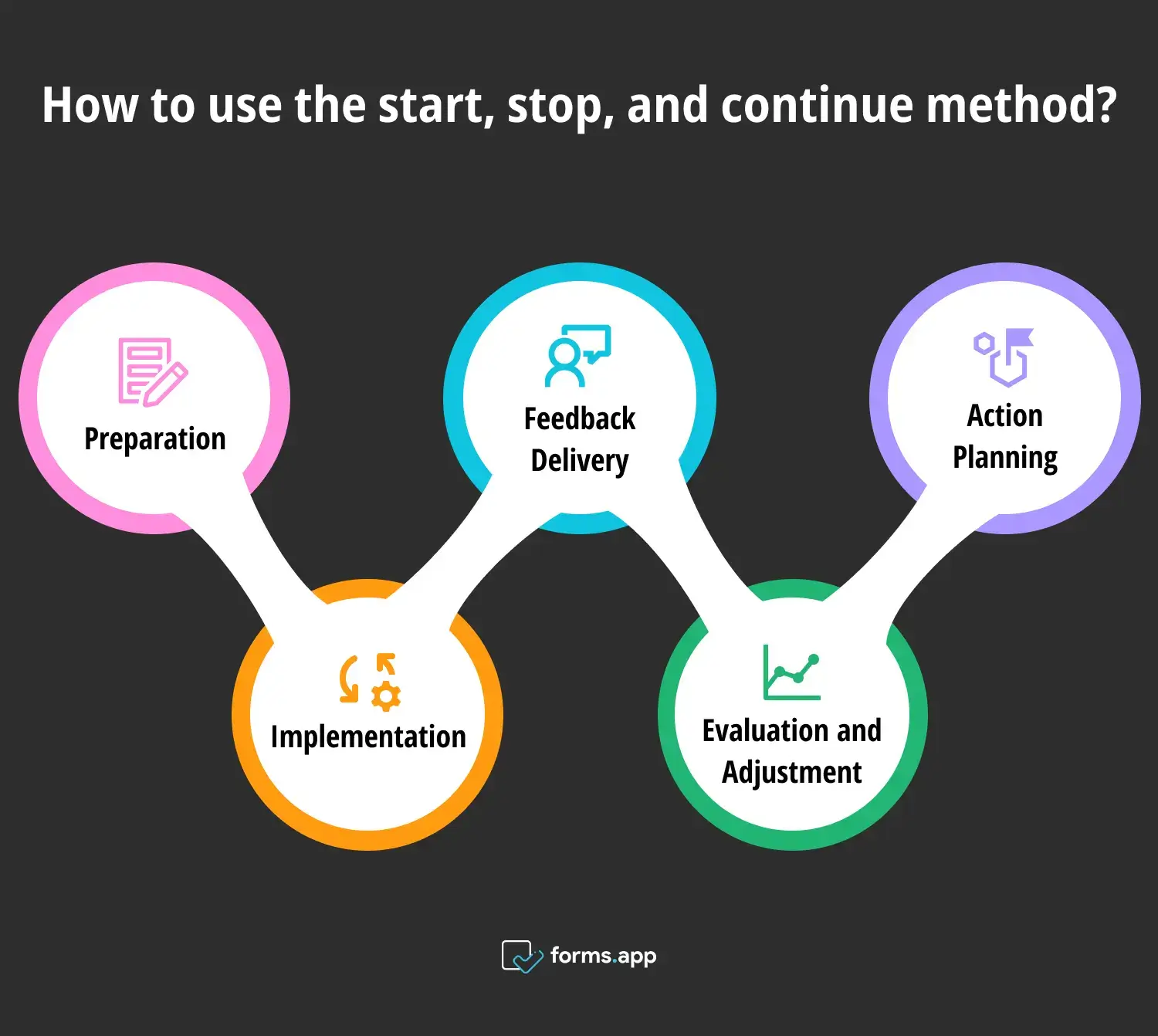
Steps to use the start, stop, and continue method
1- Preparation
Before implementing the Start, Stop, Continue method, it's crucial to gather relevant information and reflect on the goals and objectives. Identify specific areas where feedback is needed and gather data or observations to support your assessment. Reflect on the impact of actions and behaviors on overall performance and consider how the Start, Stop, Continue framework can facilitate improvement.
2- Feedback Delivery
When delivering feedback using the Start, Stop, and Continue method, it's essential to be specific and objective. Clearly communicate the behaviors or actions that need to start, stop, or continue, providing examples to support each point. Focus on behaviors rather than personal attributes and ensure that feedback is delivered in a constructive and supportive manner to encourage growth and development.
3- Action Planning
After delivering feedback, work collaboratively with individuals or teams to develop an action-oriented plan based on the identified areas for improvement. Set clear and achievable goals for starting, stopping, and continuing specific actions or behaviors. Define actionable steps, timelines, and responsibilities to ensure accountability and progress toward desired outcomes.
4- Implementation
Once the action plan is in place, it's time to implement the identified changes. Encourage individuals or teams to proactively start new practices, cease counterproductive behaviors, and continue successful actions. During a team meeting, introduce the Start-Stop-Continue method to facilitate open discussion and collaborative decision-making. You can do this by using sticky notes.
5- Evaluation and Adjustment
Regularly evaluate the progress and effectiveness of the actions taken based on the Start, Stop, Continue feedback templates. Schedule follow-up meetings to review achievements, identify areas for further improvement, and adjust the action plan as necessary. Celebrate successes and acknowledge efforts made towards positive change, while also remaining open to refining strategies for continuous growth and development.
Stop, start, continue feedback examples
Let’s look at some Stop-Start-Continue examples in various contexts. Examples serve as illustrative tools to demonstrate the versatility and effectiveness of this feedback framework. You can explore diverse scenarios where managers, individuals, or colleagues can use the Start-Stop-Continue approach to drive positive change, foster growth, and enhance performance:
Stop, start, continue feedback examples for a manager
Stop:
- Stop micromanaging team members and instead trust their capabilities and empower them to take ownership of their tasks.
- Stop neglecting to provide timely and constructive feedback, as it hinders employee growth and performance improvement.
Start:
- Start delegating tasks more effectively, allowing team members to develop new skills and take on greater responsibilities.
- Start fostering a culture of open communication and transparency within the team to encourage collaboration and idea-sharing.
Continue:
- Continue providing support and guidance to team members, acknowledging their contributions, and celebrating their successes.
- Continue setting clear expectations and goals, and regularly checking in with team members to provide feedback and support their professional development.
Stop, start, continue personal development examples
Stop:
- Stop procrastinating on important tasks and instead develop better time management strategies to improve productivity.
- Stop avoiding challenging situations or opportunities for growth due to fear of failure or self-doubt.
Start:
- Start seeking out new learning opportunities, whether through formal training programs, online courses, or mentorship relationships.
- Start practicing self-reflection and mindfulness techniques to increase self-awareness and personal growth.
Continue:
- Continue setting personal development goals and tracking progress towards them, adjusting strategies as needed.
- Continue seeking feedback from peers, mentors, and supervisors to identify areas for improvement and refine personal development plans.
Stop, start, continue feedback examples for colleagues
Stop:
- Stop interrupting colleagues during meetings or discussions, as it disrupts the flow of conversation and diminishes productivity.
- Stop withholding information or resources that could benefit team members, as it hinders collaboration and teamwork.
Start:
- Start actively listening to colleagues' ideas and perspectives, showing respect for their contributions, and fostering a more inclusive work environment.
- Start offering support and assistance to colleagues when needed, demonstrating a willingness to collaborate and help others succeed.
Continue:
- Continue recognizing and appreciating colleagues' efforts and achievements, fostering a positive and supportive work culture.
- Continue communicating openly and transparently with colleagues, addressing issues or concerns constructively, and working together to find solutions.
When you should use the start-stop-continue method
Now, let’s see when to benefit from the Start-Stop-Continue method. Understanding the contexts where this feedback framework thrives is crucial for effective implementation. Let's explore six diverse environments where to leverage the Start-Stop-Continue method to promote growth, collaboration, and continuous improvement.
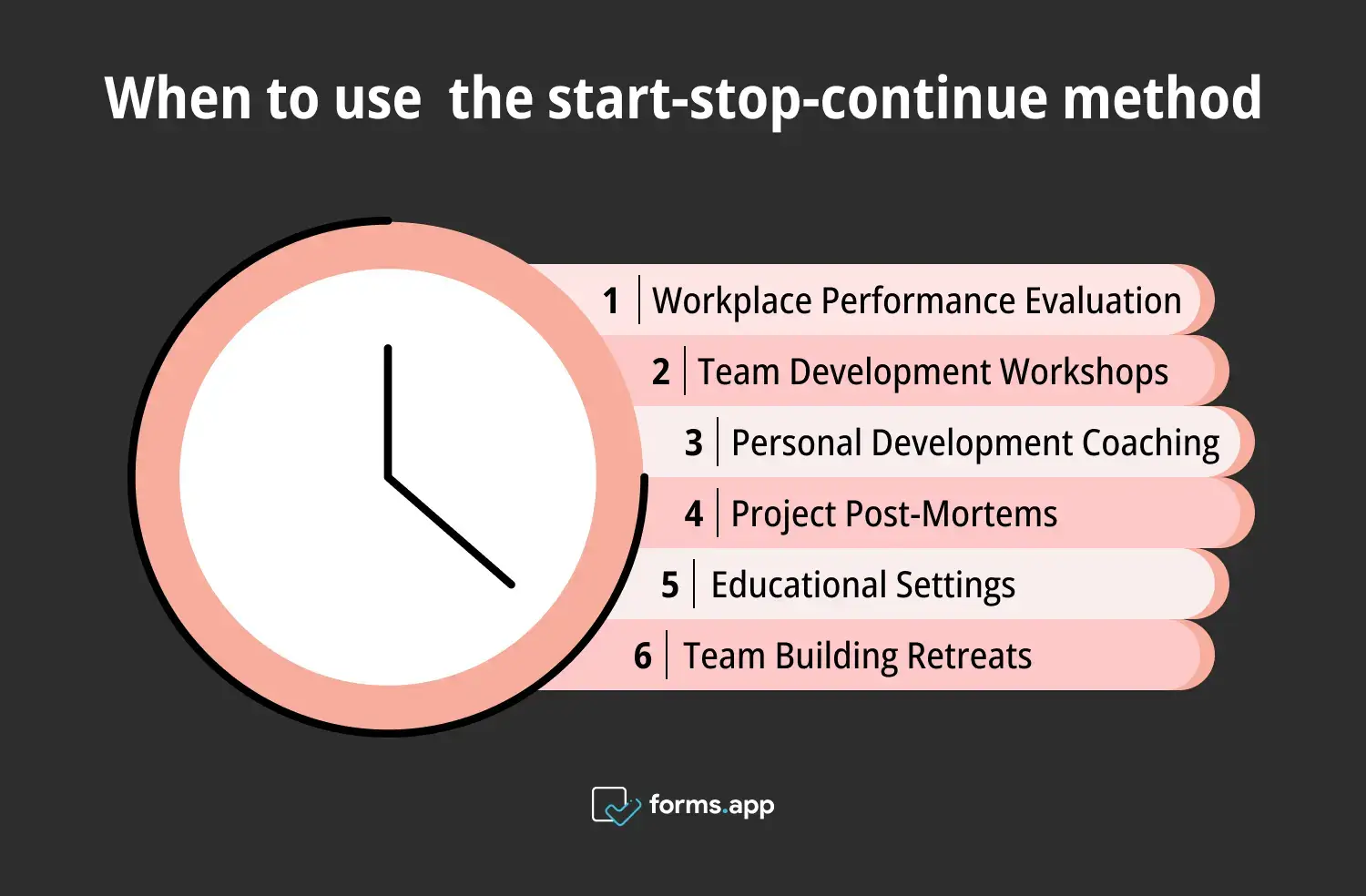
Right times to use the start-stop-continue method
🕛Workplace Performance Evaluation: Use the Start-Stop-Continue method during performance evaluations to provide structured feedback. Identify actions to start for skill development, stop for unproductive habits, and continue for successful behaviors, fostering growth and improvement.
🕛Team Development Workshops: Employ the Start-Stop-Continue method in team development workshops to promote reflection and collaboration. Team members identify actions to start for team cohesion, stop for communication barriers, and continue for effective strategies, enhancing teamwork and productivity.
🕛Personal Development Coaching: Utilize the Start-Stop-Continue method in personal development or brainstorming sessions to guide individual growth. Clients identify actions to start for self-improvement, stop for limiting beliefs, and continue for strengths, empowering personal and professional development.
🕛Project Post-Mortems: Apply the Start-Stop-Continue method in project post-mortems to evaluate project performance. Team members identify actions to start for future projects, stop for project pitfalls, and continue for successful project management practices, facilitating continuous improvement.
🕛Educational Settings: Implement the Start-Stop-Continue method in educational settings to promote student reflection and growth. Students identify actions to start for academic success, stop for ineffective study habits, and continue for effective learning strategies, fostering student development and achievement.
🕛Team Building Retreats: Integrate the Start-Stop-Continue method into team building retreats to enhance team dynamics. Team members identify actions to start for team bonding, stop for conflicts or misunderstandings, and continue for effective collaboration, strengthening relationships and teamwork.
Pros & Cons of the start, stop, and continue method
It's essential to recognize the potential benefits and limitations of the Start-Stop-Continue method. Understanding both sides of this feedback framework equips individuals and organizations with insights to make informed decisions about its implementation. Let's explore the advantages and disadvantages of utilizing the Start-Stop-Continue approach in various contexts.
Pros:
➕Structured Feedback: The Start-Stop-Continue method provides a structured framework for giving and receiving feedback, ensuring clarity and focus on actionable steps for improvement.
➕Promotes Growth Mindset: Encourages a growth mindset by focusing on opportunities for learning and development, fostering a culture of continuous improvement.
➕Enhanced Self-Awareness: Promotes self-awareness among individuals and teams, helping them identify strengths, weaknesses, and areas for improvement.
➕Encourages Accountability: Encourages accountability by assigning specific actions to individuals or teams, fostering ownership and responsibility for change.
➕Effective Communication: Facilitates open and constructive communication between managers, employees, and team members, promoting transparency and trust.
➕Flexibility and Adaptability: Allows for flexibility and adaptability in response to changing circumstances, enabling individuals and teams to adjust their actions and strategies as needed.
Cons
➖Potential for Misinterpretation: Misinterpreted feedback can negatively impact morale and productivity, highlighting the need for clear communication and sensitivity when providing feedback.
➖Overemphasis on Negatives: The focus on identifying actions to stop may lead to an overemphasis on negatives, potentially overshadowing achievements and positive contributions.
➖Limited Scope: The Start-Stop-Continue method may have a limited scope in addressing complex or systemic issues within an organization, requiring additional strategies or interventions for comprehensive solutions.
Frequently asked questions about the start, stop, and continue
Now, we will address some Start-Stop-Continue questions asked frequently to enhance our understanding of the topic. Exploring common queries provides clarity and deeper insights into the subject matter. Let's delve into these FAQs to shed light on key aspects and provide comprehensive answers for a clearer understanding.
Start, Stop, and Continue exercises involve identifying actions to initiate (start), cease (stop), or maintain (continue) for personal or professional development. Individuals reflect on past behaviors, assess their effectiveness, and determine actionable steps for improvement or continuation.
To answer a Stop-Start-Continue prompt, reflect on past actions and behaviors. Identify habits or practices to cease (stop), new actions to initiate (start), and successful behaviors to maintain (continue), providing specific examples and actionable steps for improvement.
The stop-continue-start behavior refers to the process of identifying actions or behaviors to discontinue (stop), maintain (continue), and initiate (start) for personal or professional development. The stop-continue-start examples involve reflecting on past practices, assessing their effectiveness, and determining actionable steps for growth and improvement in various aspects of life or work.
The start-keep-stop approach is a feedback framework similar to start-stop-continue, where individuals or teams identify actions to initiate (start), maintain (keep), and cease (stop) for personal or professional development. The start-keep-stop examples involve reflecting on effective practices to continue, areas needing attention or improvement, and behaviors to discontinue for growth and success.
Conclusion
In conclusion, the Start-Stop-Continue method offers a structured approach for fostering growth, enhancing communication, and driving continuous improvement. By implementing this feedback framework in various environments, individuals and organizations can identify actionable steps for personal and professional development, promote collaboration, and achieve desired outcomes.
Today, we've explored the versatility and effectiveness of the Start-Stop-Continue method across diverse contexts. Whether in performance evaluations, team workshops, or personal development endeavors, this feedback framework empowers individuals and organizations to drive positive change and achieve their goals. Incorporate it into your business practices by creating your own start-stop-continue template today!
- What is the start, stop, and continue method?
- How to use the start, stop, and continue method?
- Stop, start, continue feedback examples
- When you should use the start-stop-continue method
- Pros & Cons of the start, stop, and continue method
- Frequently asked questions about the start, stop, and continue
- Conclusion
forms.app, your free form builder
- Unlimited views
- Unlimited questions
- Unlimited notifications
